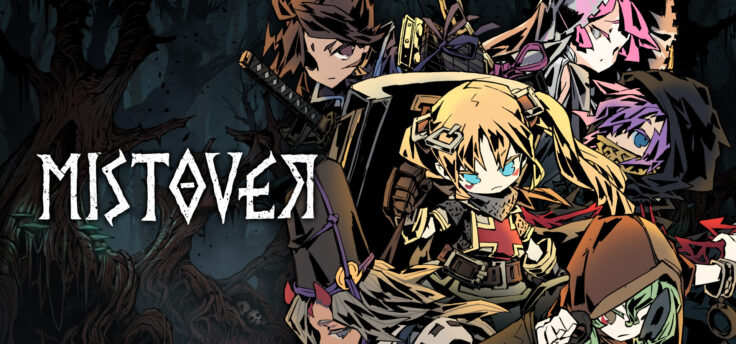Another worthy addition in the tactical turn-based dungeon crawler family.
Type: Single-player
Genre: RPG, Adventure, Strategy,
Turn-based, Dungeon Crawler
Developer: KRAFTON, Inc.
Publisher: KRAFTON, Inc.
Release date: 10 Oct, 2019


The Premise
‘Mistover’ is a dungeon crawler with plentiful resource management, dungeon exploration, and turn-based battle system, all with a somewhat dark anime aesthetic. In many ways it’s similar in its presentation and gameplay to Darkest Dungeon, though with some of its own differences. Let’s take a look deeper at how the game executes each of its features and if it all works well.
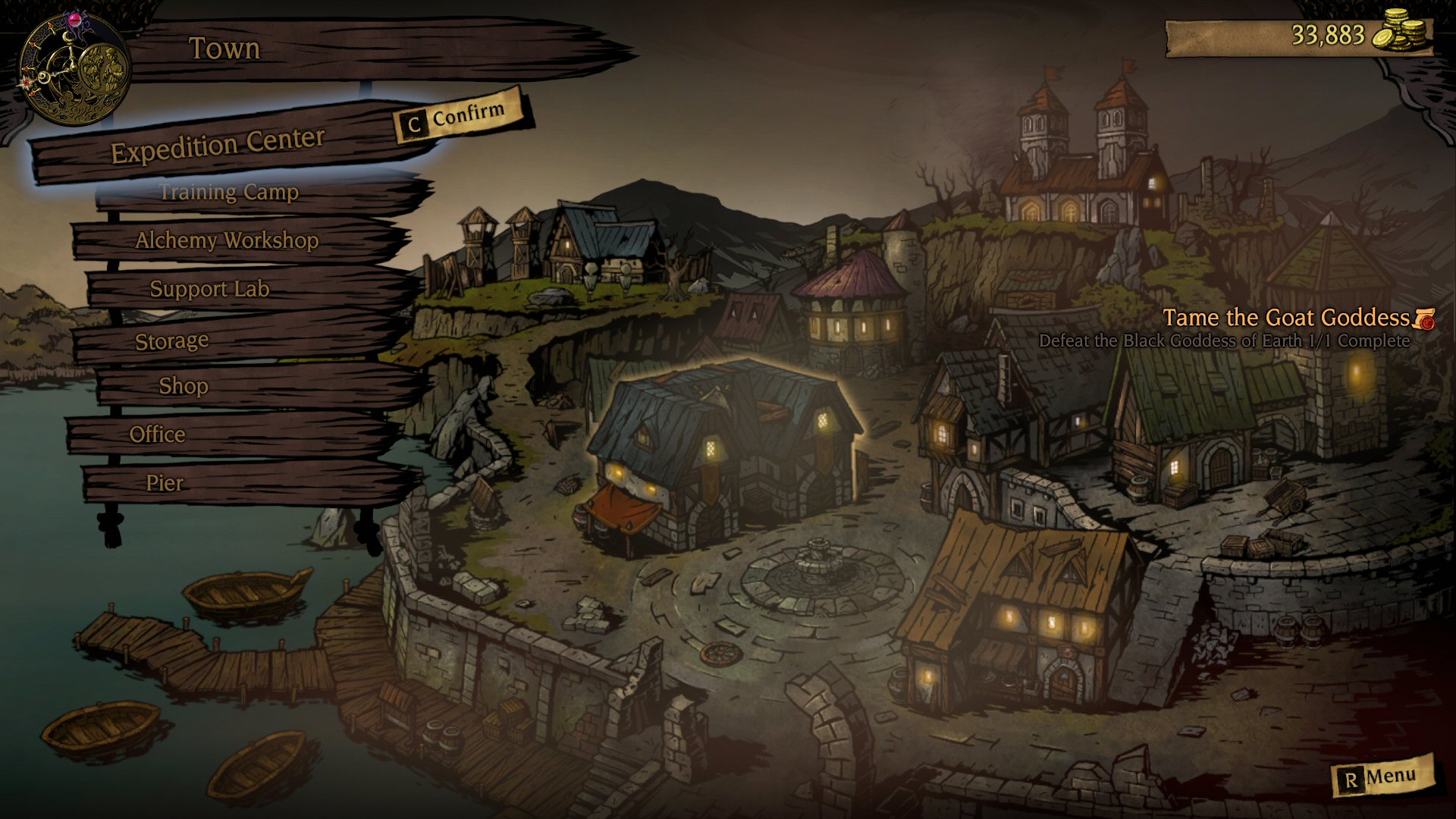
Story and Narrative
The main plot revolves around a strange mist that starts to spread and covering the village, and unusual-looking monstrosities appearing in the surrounding area. So we get tasked by the village leader to go into each location and uncover what the cause of the mist is. It’s a simple story premise that services the gameplay. The story and lore do continue to take part in the overall experience and do not serve only as an excuse to go dungeon crawling. Whenever we accomplish quests, we report back to those in charge of the village and they update us further on the developing events. The game uses some interesting ideas from myths and folklore and tries to incorporate them into its plot.
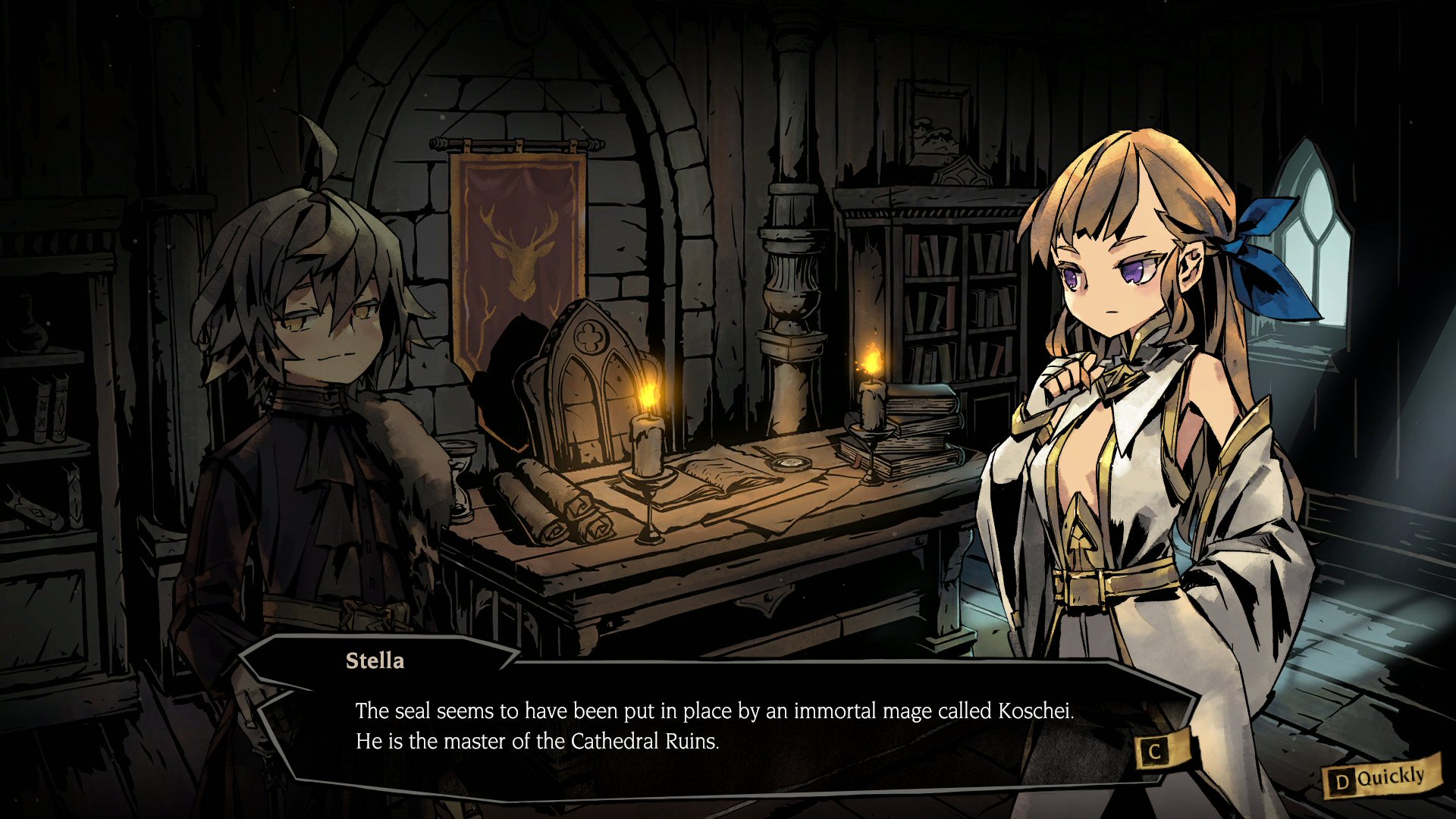
Gameplay – Management
Before we go into the dungeons, there is plenty of management to do in the village. As with some other games of this type, the hub area has different buildings for different purposes, such as buying consumables, upgrading gear, recruiting and upgrading character units, and so on.
There are several different character classes fitting various playstyles and roles: paladin, cleric, ronin, witch, shadowblade, and so on. Each of these classes has a big list of skills they can learn, although they start with only some of them and can have only a handful of them equipped at any one time. Learning new skills in this game isn’t as simple as merely spending resources or levelling up. It requires the presence of another character of the same class who possesses that skill, who then passes on their knowledge and disappears off the face of the Earth. It’s a bit of a strange implementation and can even be confusing at first, because the character who teaches one of their skills to another will be gone for good.
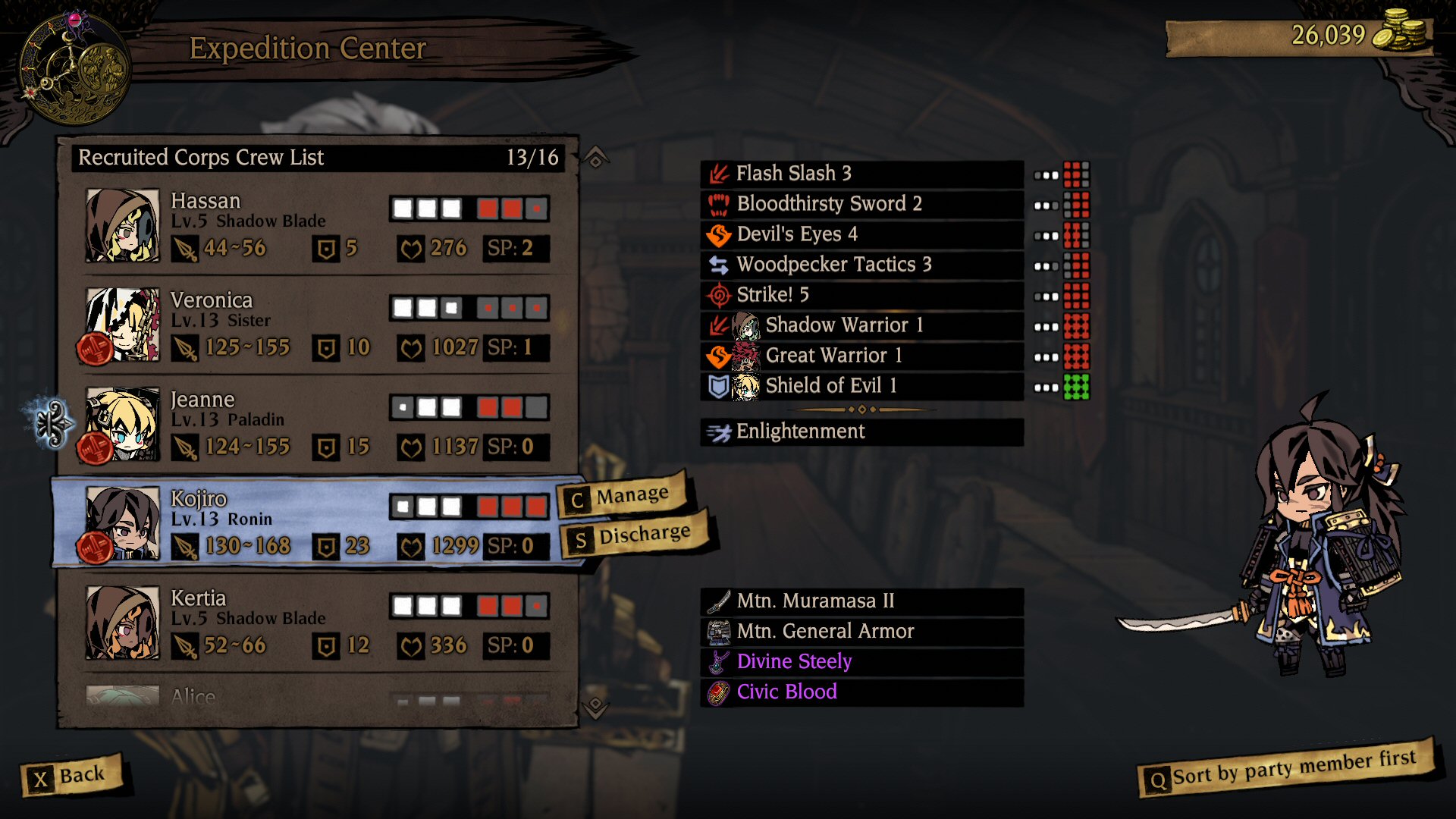
Each of our recruited characters can also be equipped with gear that we find during our exploration of dungeons. As we find better pieces, we get to improve the attire our characters wear that provide them with better bonuses. The mechanics are quite standard on this front. Although virtually every piece of gear carries not only positive but also negative stat changes, so you have to decide what you’re willing to sacrifice and for what.
Our characters can also acquire jinxes when they level up. For those familiar with Darkest Dungeon, jinxes here are basically what character quirks are in Darkest Dungeon. They modify the character stats or behaviour in some way, e.g. 10% extra speed after performing a critical hit. They can be positive or negative, however, so if our characters acquire negative jinxes, then we need to spend money and resources to “fix” them.
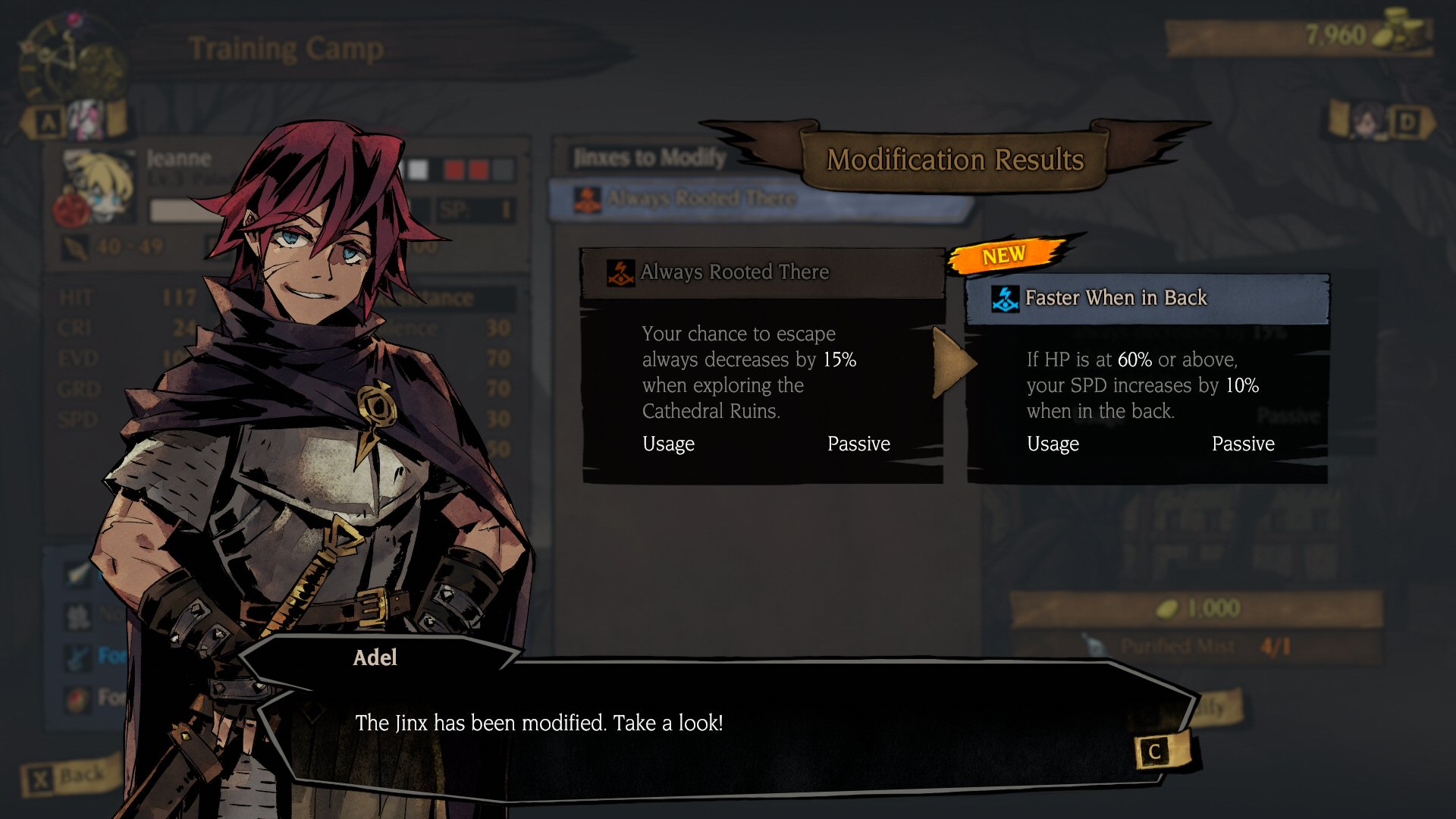
One of the things that does start to get annoying by mid to late game is having to clear up your storage space off subpar items that you no longer need. The total storage space of all items we have is limited (but can be upgraded over time), and with the amount of loot we find and quest rewards we get, this storage space gets filled up by mid game and you constantly have to spend time on clearing storage space for new things that you wish to buy from the merchant. Unlike the limit on how much we can bring to the dungeons, which makes sense, I think having a limit on total storage space in the village is a bit pointless and annoying. It doesn’t increase the difficulty of the game and only causes players to waste time on clearing storage space in between missions.
One other mechanic I am not fond of is the fusion of equipment. With the right resource we can fuse two pieces of gear together, at which point one of the two will randomly be chosen to get sacrificed, while the other receives one of its bonuses. It’s too luck-dependent for my liking and I found myself using this mechanic very rarely.
Gameplay – Dungeon and Combat
When we first begin, we only have one area available which we can explore. However, once we complete all the main missions in it, we unlock the next one, and so on. In that sense, there is progression and each area gets harder and harder. Each area also contains several different locations, all with their own layout, loot drops, and enemy difficulty.
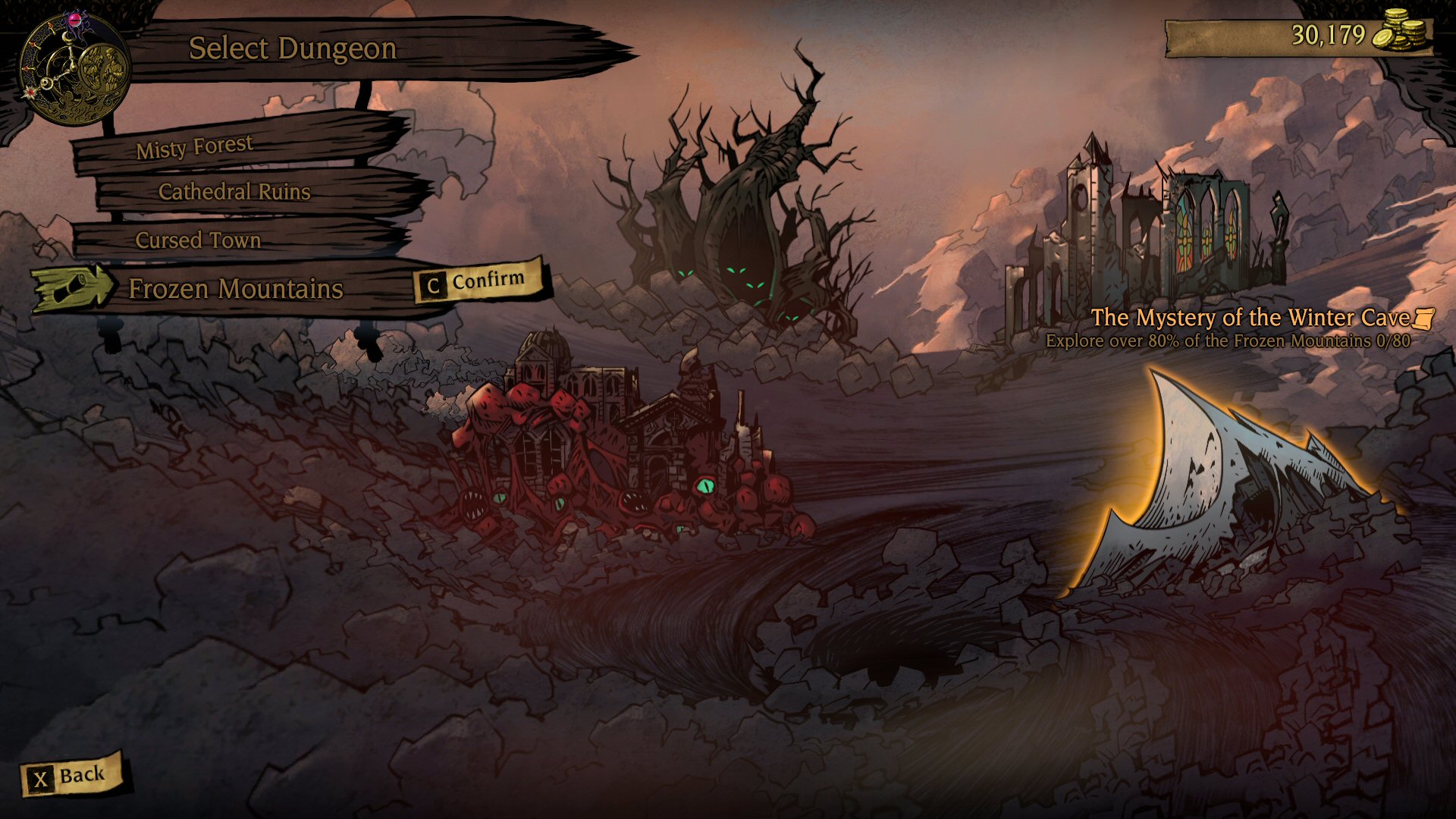
Once we’ve chosen the dungeon area to go to, we then need to decide on two things. Firstly to pick our team of up to 5 character units and to put them in a formation that suits us. Secondly to decide on what consumable items to take with us. The game encourages us to strike balance with what we bring and not to take too much. The total amount of stuff we can bring is limited, and also, because the dungeons are filled with strange otherworldly forces, some of our unused consumables will get corrupted at the end of the mission and have a much weaker potency. For example, if a potion gets corrupted, it will only heal a fraction of HP than the uncorrupted potion would. So, if we don’t want too much of our good stuff losing potency, we have to bring just enough with us to the dungeons.
Once in the dungeon, we find ourselves on a sort of grid, where we can go north, south, west, east, and in diagonals if no obstacles block our path. We have to explore the dungeon, search debris for loot, and open treasure chests (which require us to find suitable keys that fit their type). This all counts towards the total completion of this dungeon level. We also encounter monster units in the dungeons too. Some will try to ignore us, but most will attempt to close in on our position once we’re in view, in which case we have to outsmart them and make sure we touch them first before the battle screen comes up. You see, we walk through the dungeon tiles on a turn-based basis, and so do the monsters. Every time we move by a tile, the monsters do too. If we touch the monster before it touches us, we get to attack it first in the battle screen.
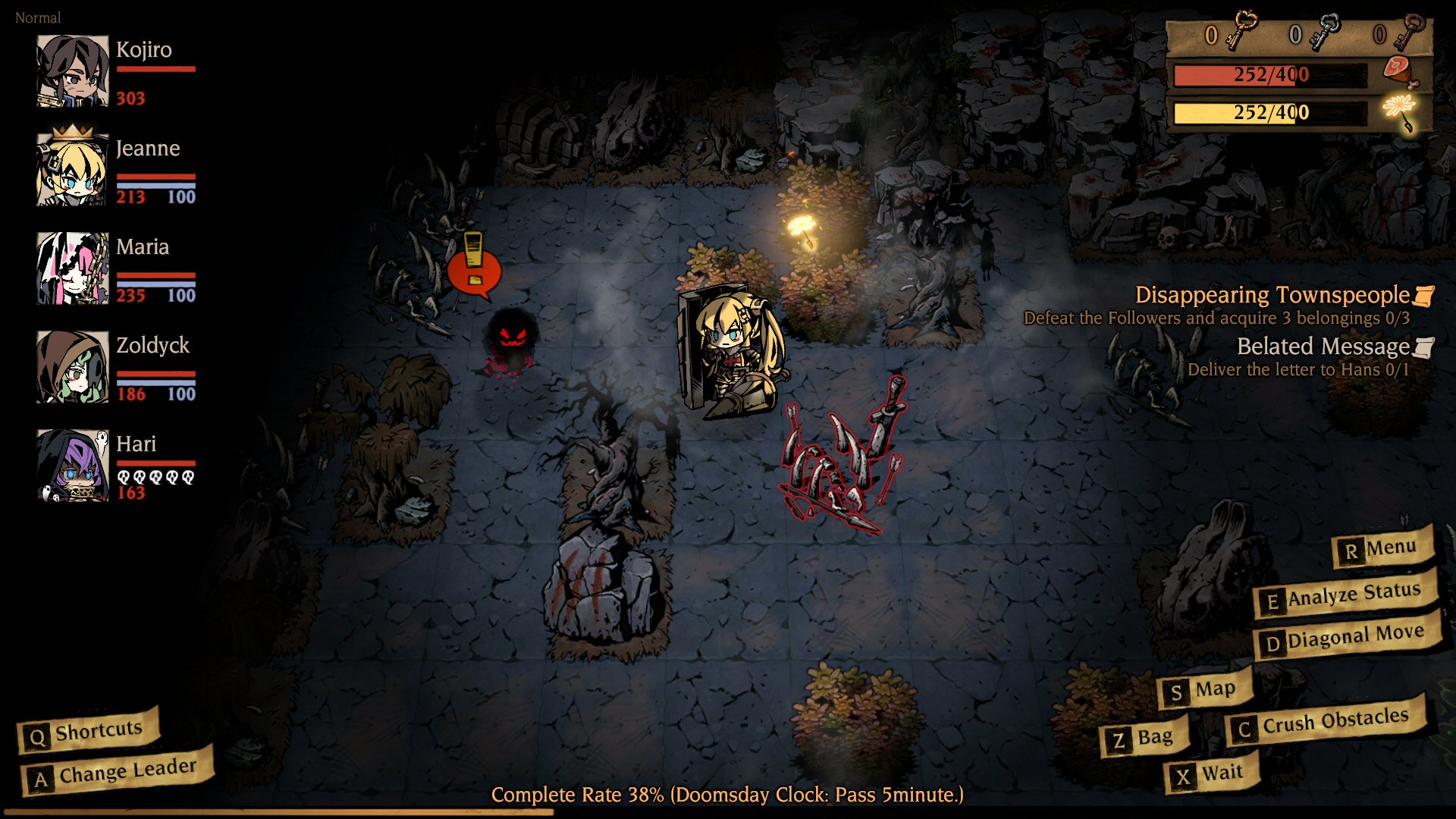
In the battle screen, we see our units and enemy units in a formation. The formation has 3 rows and 3 columns (so, 9 positions in total for heroes and the same for enemies). The formation is important because the skills our heroes use are position-sensitive. Some skills might not be able to be used from a back row, some won’t be used from a front row, and so on. Likewise, which enemy rows we can target also varies. Some skills might only be able to target first two rows for example. Some skills will have more unique target patterns, for example hitting an entire row of enemies or hitting them in a cross-shape.
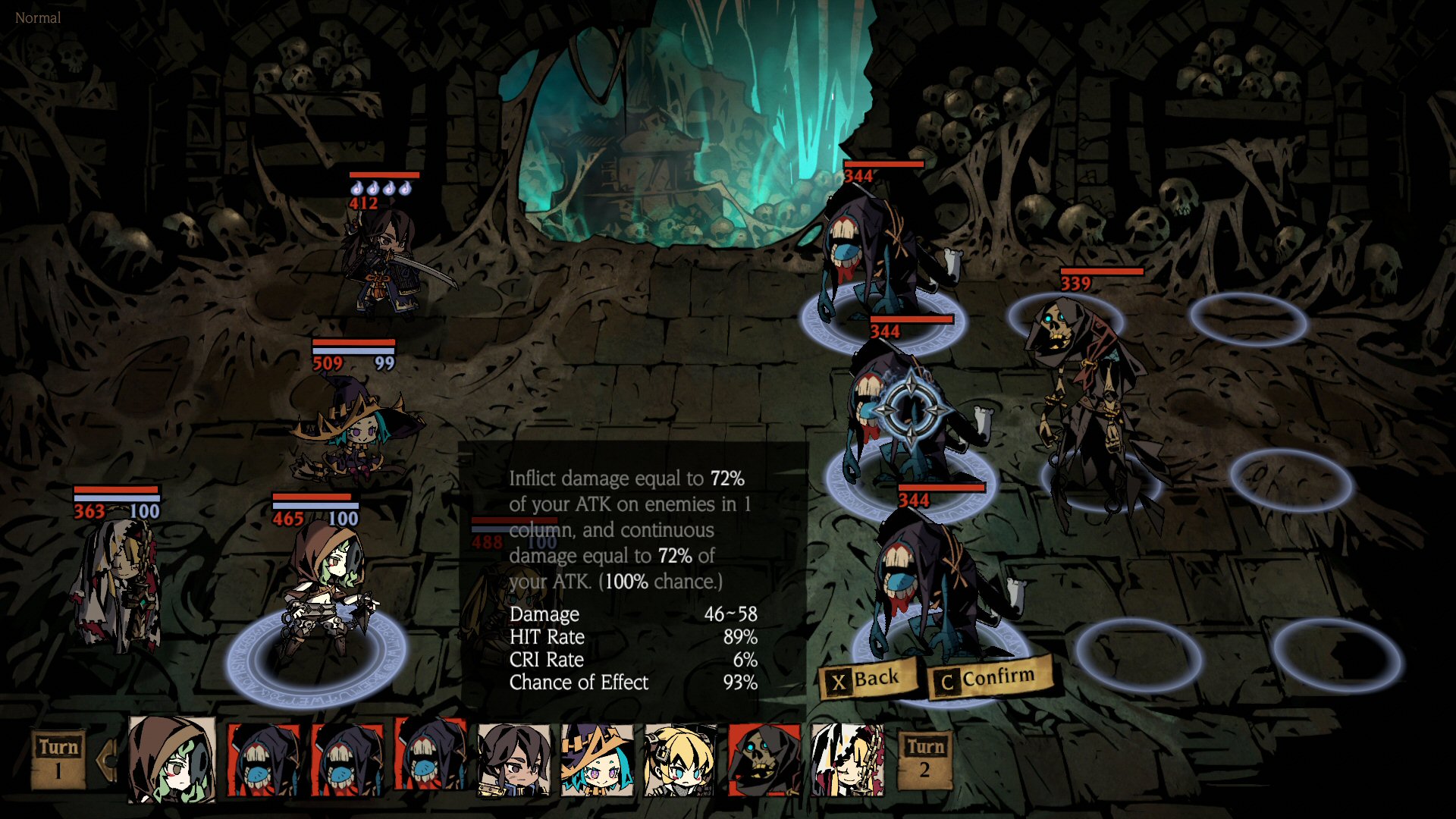
In addition to that, our heroes over time also learn co-op skills. These are generally stronger, but they require a character of a specific class next to them – either in front of them or behind them or to the side of them. For example a witch can cast a spell that hits all enemies for good damage while healing her in the process so long as a ronin character is positioned somewhere to the side of her (along the same battle row). All this makes positioning of our heroes highly important if we want to maximise the use we get out of each of them.
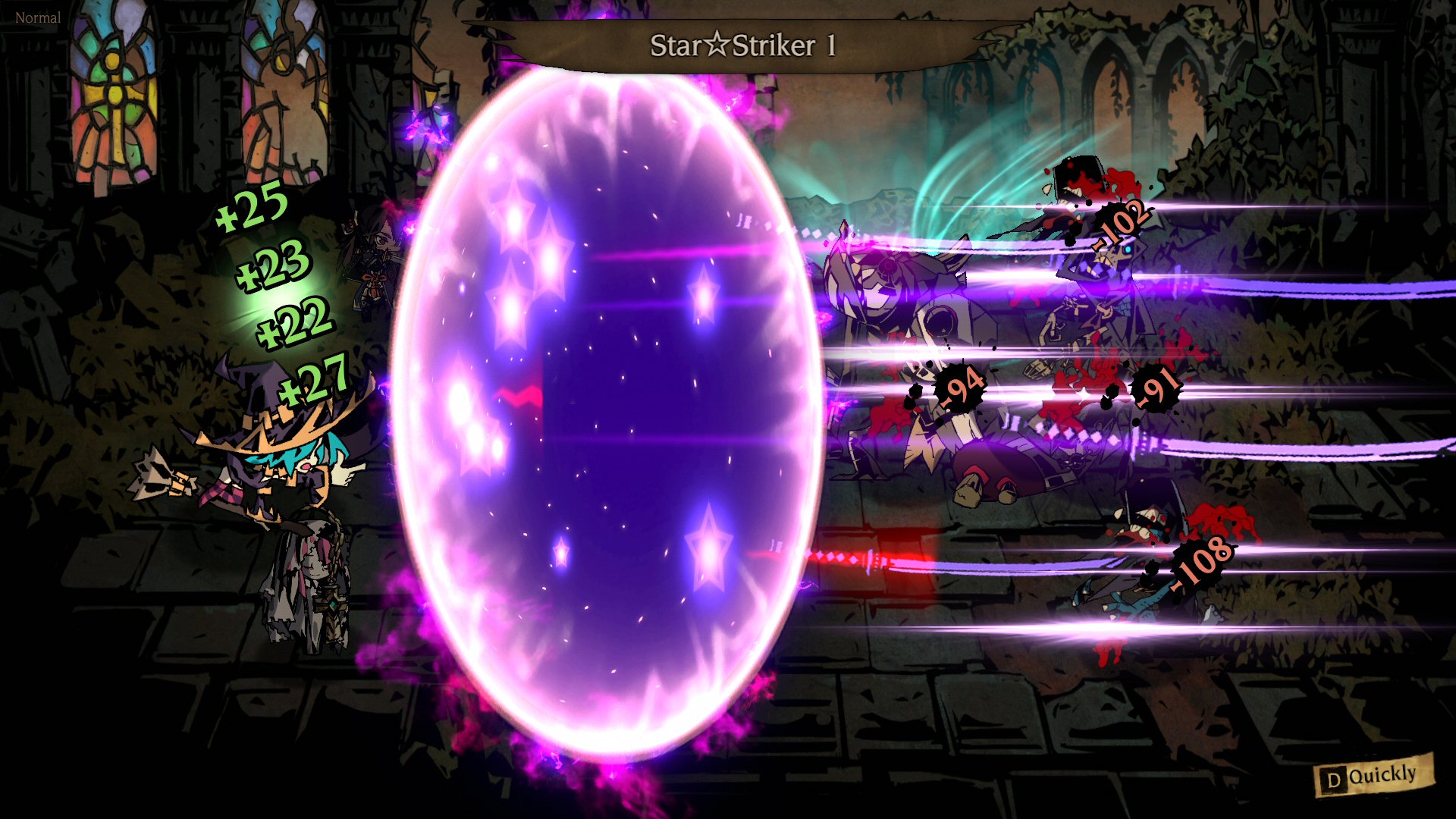
The general flow of battle is quite similar to other turn-based games of this type, particular JRPGs. We can damage enemies, we can heal, we can use items, we can inflict status effects onto enemies, and we can also move to a different part of the formation (though this wastes a turn for that character). Some skills also allow us to move the enemies, like push them back by a row or bring them forward by a row. This helps us put enemies where we can better target them with our best skills or bring them closer to other enemies where AoE skills will be able to hit maximum possible number of targets. I quite enjoyed this chess-like approach to battle and deciding several moves in advance where I want my enemies to be so to defeat them in as few turns as possible.
We don’t have to engage in battle with every monster squad we come across in the dungeon of course. There are ways we can avoid them, like by hiding in the bushes for example. Each character class also has a unique on-map skill, and we can cycle between the characters we brought along and make them use the skill. For example, paladin can smash obstacles with her shield (not having her means our team suffers a HP penalty when destroying an obstacle), or witch for example can teleport us to another part of the map randomly and avoid a monster encounter.
Finally, we also need to watch out for our hunger and light levels when exploring the dungeons. Each time we move by a tile, our fullness decreases by a bit and our illumination also decreases. We can replenish these with the consumable items we bring along with us or find in the dungeons. Fullness is needed to prevent HP damage when exploring. Having 0 fullness means our team gets hurt each time we move by a tile. Illumination is needed to see further tiles around us and also to increase the chances of us taking our turns before the monsters when a battle encounter starts.
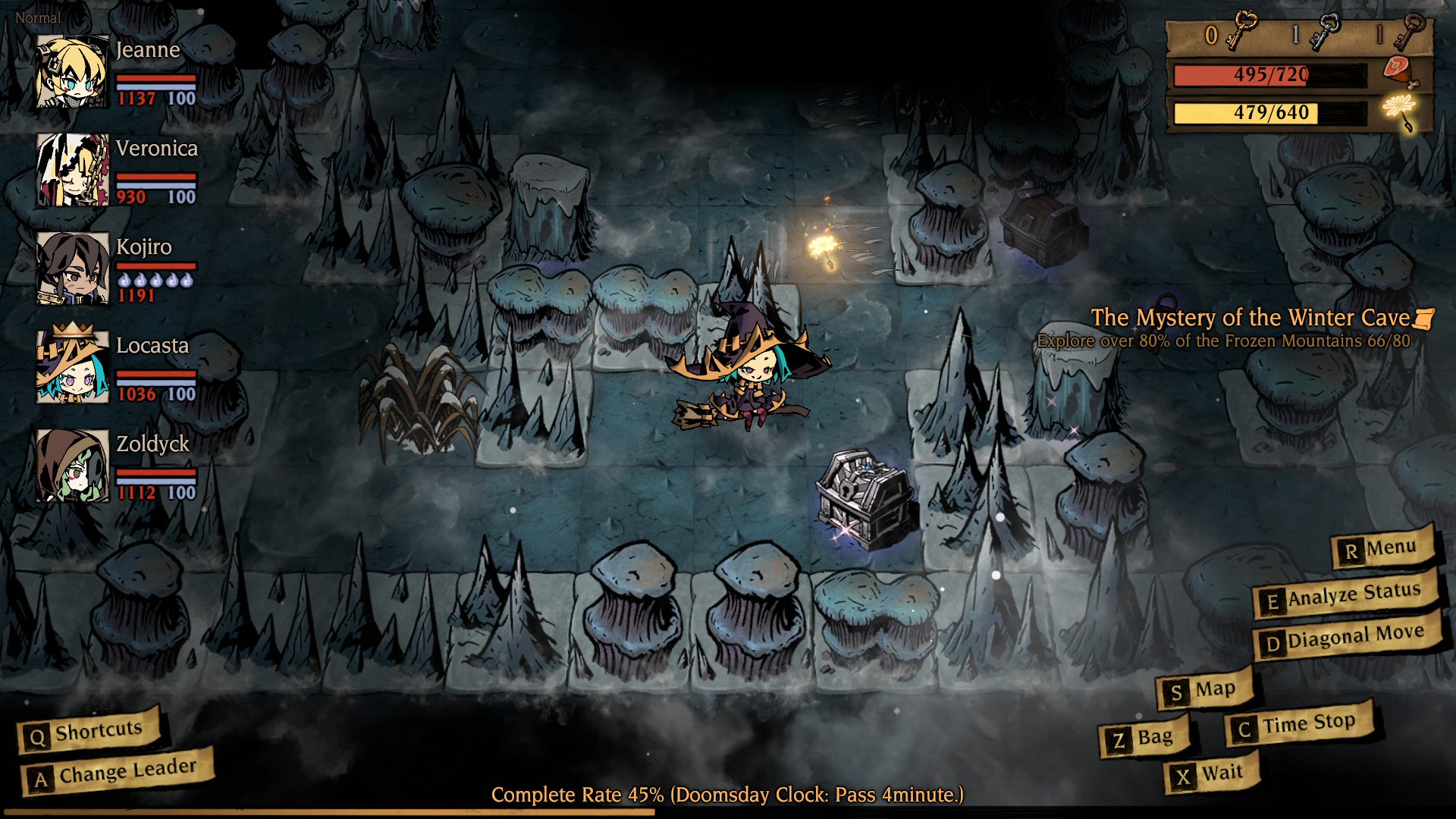
One last thing that is important in the game and which is part of the fail condition is the Doomsday Clock. If we explore the dungeons sufficiently, then the Doomsday Clock does not move forward (or might even move backwards, which usually happens on boss maps). But if we don’t explore it enough or don’t fight enough monsters in it, then the clock will move forward by a bit. If it reaches midnight, the otherworldly forces become too strong and conquer the world, so you lose the game. This is a pretty great idea that creates a fail condition and which encourages dungeon exploration to be thorough. We don’t have to explore absolutely everything, but we need to explore a sufficient amount in order to keep the Doomsday Clock still.
As with most types of games like this, the repetitiveness can be felt after a while. The combat is quite strategically deep and there are plenty of things to manage in the game, but when you do the same battles over and over, it starts to feel repetitive. In that sense, I did feel that in some dungeons there were too many enemy encounters of very similar enemy compositions, which made those levels feel too grindy. On the other hand, repetitiveness and grind is something that can be experienced in virtually every dungeon crawler, so it wouldn’t be fair for me to criticise this game above others for this issue.
Presentation
The visual style the game has is quite charming and manages to provide a good atmosphere of treacherous locations and otherworldly presence. It manages to be both dark and colourful at the same time. In many ways it is reminiscent of Darkest Dungeon’s visual style, although the character art is significantly different. Here the characters are done in anime style. So overall it feels like some sort of dark and gritty anime.
Despite so many mechanics and things to learn in the game, the graphical interface is intuitive and conveys all this information clearly. In battles, the animations use still images and screen effects, akin to Darkest Dungeon again. It works well and makes each hit and ability feel impactful.
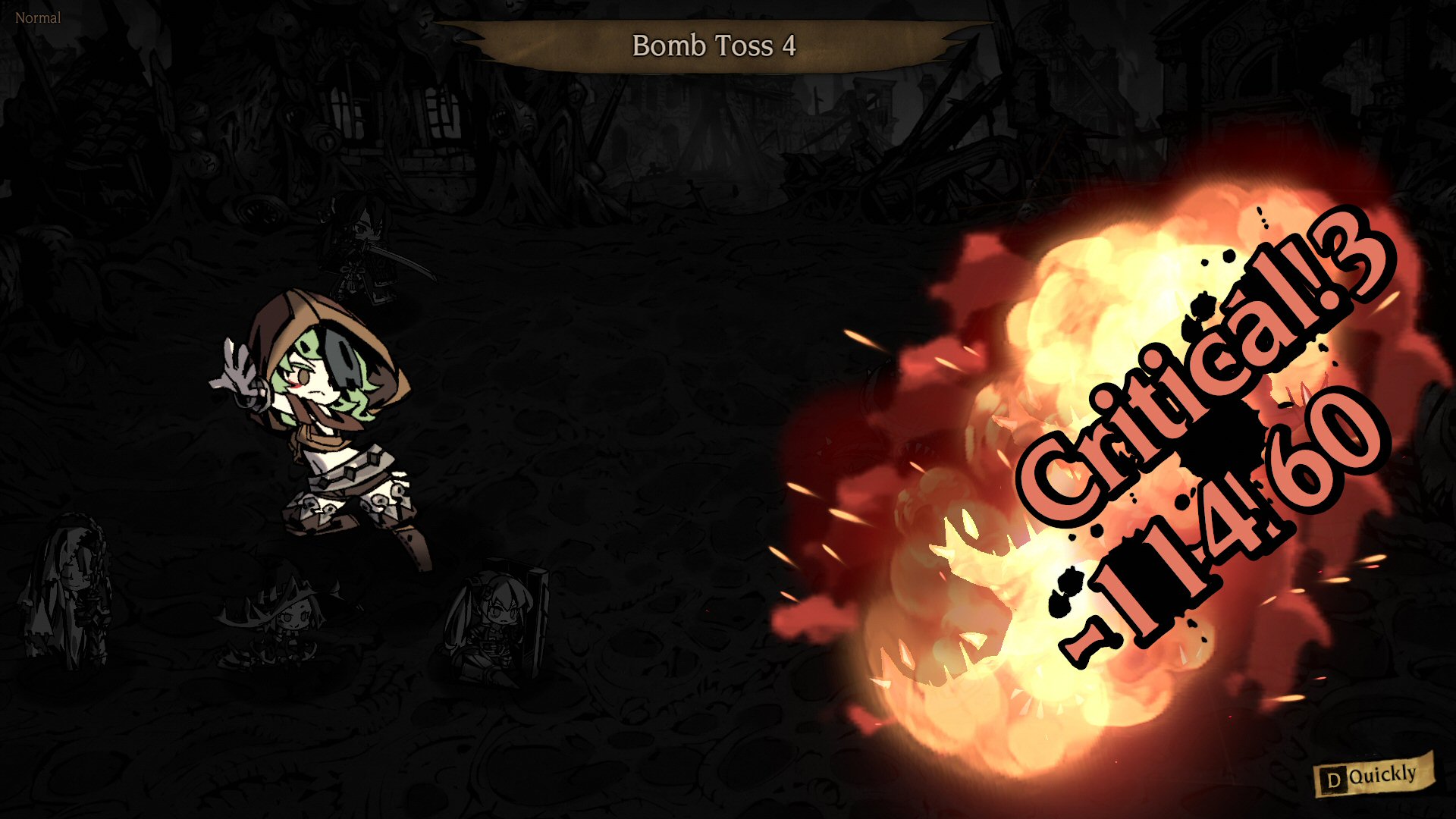
The music is fitting to the setting and works well. The sound effects are also pulled off well, especially during attacks in battle to give the strikes that extra oomph. There is voice acting present in the whole game, although it’s all in Japanese.
I did come across a couple of small bugs that were a bit annoying, though not game-breaking. One of the bugs happens at times when scrolling through item menus, usually in the shop sell screen. When selecting the items on this screen, an option to sell them has to come up, but it doesn’t do it for many items once the inventory grows in size, so you have to either click something else first before clicking what you want to sell or use the keyboard shortcut. Another minor bug was in dungeons. If the bag space is full when we try to pick up new items, we can go to our bag and discard some items, before adding new items there. On many occasions after doing this, the UI for different functions disappears off the screen unless you interact with something else in the environment or use a keyboard shortcut for something.
I also think it would’ve been very beneficial to make it easier to compare stats on different pieces of gear in the equip menu. When we select a new item that we want to equip, it only tells us which stats will go up and which will go down compared to our currently equipped one, but doesn’t show by how much, so I often found myself going back and forth between the two and looking at each individual stat, which is not very convenient.
Verdict
‘Mistover’ is a pretty good and solid turn-based dungeon crawler that clearly draws a lot of inspiration from Darkest Dungeon. The battle system is pretty fun and well-executed, and the dungeon exploration is engaging and requires decision making. Because there are so many different mechanics, there can be a bit of a learning curve for some people, but the game’s difficulty scales up nicely on the normal mode and allows you time to learn everything it has to offer.
I have been put off for a long while now from trying this game due to it having a ‘Mixed’ user score on Steam, but recently I got a chance to try it out on another platform (still on PC) and I’m surprised that this game has a ‘Mixed’ rating on Steam. Judging by what reviews say, it seems the game might’ve been balanced badly at release, but there have been plenty of patches released by devs since, so by now the game’s difficulty and mechanics feel stable and solid. I’d certainly recommend this game to anyone who enjoys deeply tactical turn-based dungeon crawlers, particularly those who enjoyed Darkest Dungeon, so long as you don’t mind a more anime aesthetic.

